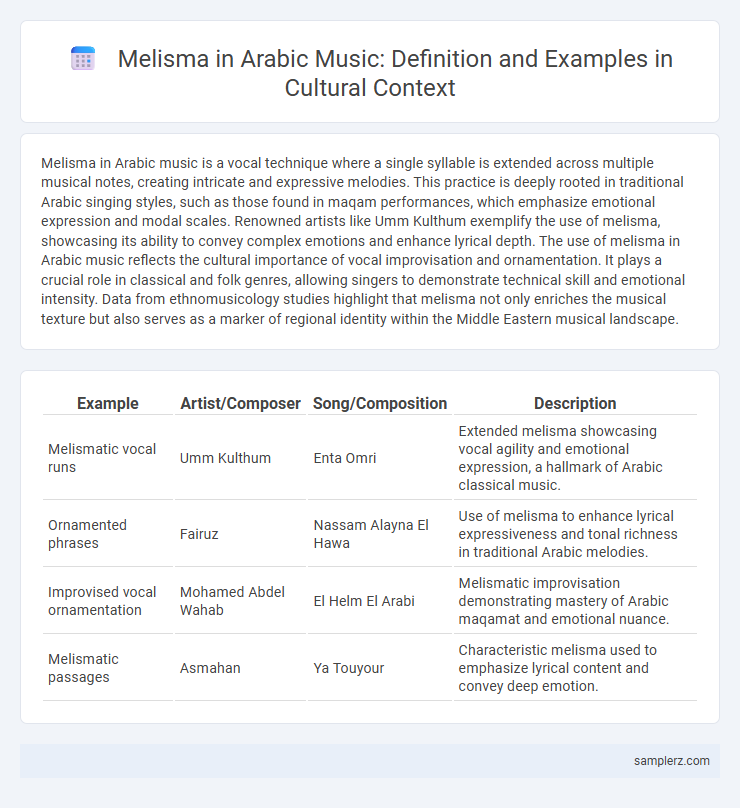Melisma in Arabic music is a vocal technique where a single syllable is extended across multiple musical notes, creating intricate and expressive melodies. This practice is deeply rooted in traditional Arabic singing styles, such as those found in maqam performances, which emphasize emotional expression and modal scales. Renowned artists like Umm Kulthum exemplify the use of melisma, showcasing its ability to convey complex emotions and enhance lyrical depth. The use of melisma in Arabic music reflects the cultural importance of vocal improvisation and ornamentation. It plays a crucial role in classical and folk genres, allowing singers to demonstrate technical skill and emotional intensity. Data from ethnomusicology studies highlight that melisma not only enriches the musical texture but also serves as a marker of regional identity within the Middle Eastern musical landscape.
Table of Comparison
| Example | Artist/Composer | Song/Composition | Description |
|---|---|---|---|
| Melismatic vocal runs | Umm Kulthum | Enta Omri | Extended melisma showcasing vocal agility and emotional expression, a hallmark of Arabic classical music. |
| Ornamented phrases | Fairuz | Nassam Alayna El Hawa | Use of melisma to enhance lyrical expressiveness and tonal richness in traditional Arabic melodies. |
| Improvised vocal ornamentation | Mohamed Abdel Wahab | El Helm El Arabi | Melismatic improvisation demonstrating mastery of Arabic maqamat and emotional nuance. |
| Melismatic passages | Asmahan | Ya Touyour | Characteristic melisma used to emphasize lyrical content and convey deep emotion. |
Introduction to Melisma in Arabic Music
Melisma in Arabic music is exemplified through intricate vocal runs and ornamentations that extend a single syllable across multiple notes, enhancing emotional expression and musical depth. This technique is fundamental in traditional maqam performances, where singers use melisma to explore microtonal variations and enrich the tonal complexity of the melody. Iconic artists such as Umm Kulthum have popularized melismatic singing, making it a distinctive feature of Arabic vocal music.
Historical Origins of Melisma in Arab Traditions
Melisma in Arabic music traces its historical origins to the classical traditions of the Arab world, particularly within the maqam system, which emphasizes intricate vocal ornamentations and elaborate melodic passages. Early examples appear in the performances of the Al-Andalusian musical heritage and the classical works of composers like Ziryab, who integrated melismatic singing to express emotional depth and spiritual intensity. This vocal technique remains a defining characteristic of Arabic music, enhancing the lyrical expression and connecting contemporary performances to centuries-old cultural practices.
Distinct Features of Melismatic Singing in Arabic Music
Melisma in Arabic music prominently features extended vocal runs on a single syllable, enhancing emotional expression and ornamentation. Traditional maqamat (modal systems) such as Rast and Bayati provide the tonal framework where singers elaborate melismatic phrases, emphasizing microtonal intervals unique to Arabic scales. This vocal technique distinguishes Arabic music by blending intricate melodic improvisations with poetic lyrical delivery, creating a rich, expressive soundscape.
Famous Arabic Songs Showcasing Melisma
Famous Arabic songs like Umm Kulthum's "Enta Omri" and Fairuz's "Kan Endak Habib" prominently showcase melisma, emphasizing the intricate vocal embellishments typical of Arabic music. These songs feature extended vocal runs that highlight the emotional depth and traditional maqam scales central to Arabic musical culture. Melisma enhances the expressiveness of the lyrics, making it a distinctive element in celebrated Arabic classical and modern compositions.
Renowned Arabic Vocalists Known for Melismatic Techniques
Renowned Arabic vocalists such as Umm Kulthum and Fairuz demonstrate exceptional mastery of melismatic techniques, where single syllables extend into intricate, flowing runs of notes. This vocal ornamentation showcases emotional depth and cultural richness, deeply rooted in the traditions of Arabic Maqam systems. Melisma in Arabic music highlights the complexity and expressiveness that define the region's musical heritage.
Melisma in Classical Arabic Music Forms (Maqam)
Melisma in Classical Arabic music, particularly within the Maqam system, showcases intricate vocal ornamentation where a single syllable is elongated over multiple notes, enhancing emotional expression. This technique is a defining characteristic of Arabic vocal performance, allowing singers to explore microtonal intervals and modal variations unique to Maqam scales such as Bayati and Hijaz. The use of melisma enriches the maqam's modal framework by emphasizing its tonal nuances and spiritual depth, crucial in preserving the traditional aesthetic of Arabic classical music.
Melisma in Contemporary Arabic Pop Music
Melisma in contemporary Arabic pop music often features elaborate vocal runs that emphasize emotional expression and melodic complexity, rooted in traditional maqam scales. Artists like Amr Diab and Sherine employ melismatic phrasing to enhance lyrical depth and showcase vocal agility. This technique preserves classical Arabic musical heritage while integrating modern pop elements for broader appeal.
The Role of Melisma in Arabic Religious and Folk Songs
Melisma in Arabic music serves as a vital expressive tool, particularly prominent in religious and folk songs where elongated vocal runs convey deep emotional and spiritual intensity. This intricate vocal ornamentation enhances the lyrical narrative, connecting listeners with the sacred themes of Islamic chants or the cultural stories embedded in folk traditions. Artists use melisma to evoke transcendence and communal identity, underscoring its central role in preserving and enriching Arabic musical heritage.
Influence of Arabic Melisma on World Music
Arabic music prominently features melisma, where a single syllable is extended through multiple notes, creating intricate vocal ornamentations. This technique significantly influences world music genres such as flamenco, gospel, and jazz, enriching melodic expression and emotional depth. The transfer of Arabic melisma highlights cultural exchange and the integration of Middle Eastern musical aesthetics into global soundscapes.
Techniques for Mastering Melisma in Arabic Vocal Performance
Melisma in Arabic music involves the intricate technique of singing multiple notes on a single syllable, exemplified by the traditional maqam system that emphasizes microtonal variations and ornamentation. Mastering melisma requires precise control of vocal agility, breath support, and pitch modulation to convey the emotional depth characteristic of Arabic vocal performance. Techniques include practicing scales within various maqamat, employing slow, deliberate phrase extensions, and imitating classical singers like Umm Kulthum to internalize stylistic nuances essential for authentic expression.

example of "melisma" in "Arabic music Infographic
 samplerz.com
samplerz.com